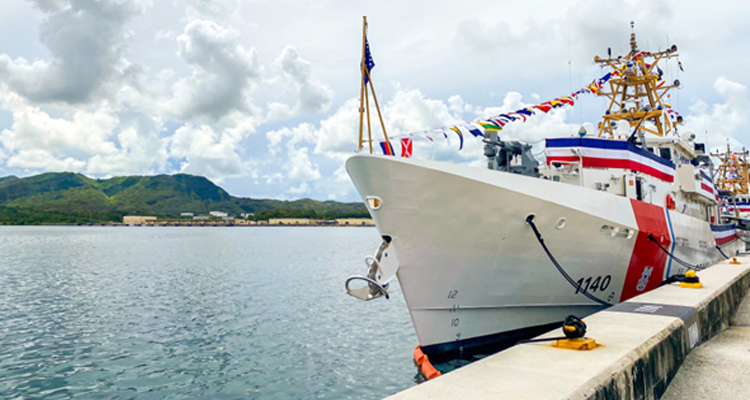July 29, 2021 —

Adm. Karl Schultz, commandant of the Coast Guard, presided over a rare triple-commissioning ceremony for Coast Guard cutters Myrtle Hazard, Oliver Henry and Frederick Hatch today in Santa Rita, Guam. U.S. Coast Guard photo by Petty Officer 1st Class Travis Magee.
The Coast Guard commissioned the 39th, 40th and 43rd fast response cutters (FRCs), Myrtle Hazard, Oliver Henry and Frederick Hatch, today in Santa Rita, Guam. FRCs will play a critical role in promoting maritime security and stability in Oceania.
“These FRCs are so capable that we bring expeditionary capability to the region that we haven’t had before,” said Adm. Karl Schultz, commandant of the Coast Guard and the presiding official for the ceremony.
The FRCs will enhance the United States’ joint efforts with the Republic of Palau, Australia, Japan and others to halt illegal, unreported and unregulated fishing in the Pacific and other transnational criminal activity such as smuggling and drug trafficking. The FRC’s wide range of capabilities also provides increased operational support for search and rescue and humanitarian missions throughout the region.
“The triple commissioning of Coast Guard cutters Myrtle Hazard, Oliver Henry and Frederick Hatch signals our dedication to regional partners and the growing maritime demand in the region,” said Capt. Nick Simmons, commander, Coast Guard Forces Micronesia Sector Guam. “It was an honor to celebrate this historic event with the crews, families and sponsors for each cutter’s namesake.”
Petty Officer 1st Class Myrtle Hazard was the first active-duty female to serve in the Coast Guard. Approximately three weeks before the United States entered into World War I, Secretary of the Navy Josephus Daniels ordered the recruitment of the first women into the naval reserves. The Coast Guard, as an arm of the U.S. Navy in wartime, also enlisted women. Hazard’s service as an electrician’s mate was unusual, as many women served in administrative positions. In fact, while much is unknown about Coast Guard women serving during World War I, Hazard has been cited as the only female electrician in the Coast Guard during that time.
Chief Warrant Officer Oliver T. Henry was one of the first African Americans in the Coast Guard to successfully transfer to a line rating from that of steward’s mate and did so well before the full integration of the Armed Forces. Henry first served the Coast Guard as a skilled petty officer aboard Coast Guard Cutter Northland during World War II and successfully moved from the wardroom as a steward to the engine room as a motor machinist mate. He was one of the service’s first minority warrant officers and served over 15 years of his 26-year career as a warrant.
Surfman Frederick Hatch, the only two-time recipient of the Gold Lifesaving Medal, was awarded his first medal for his actions as a surfman at the Cleveland Life-Saving Station for rescuing those on board the schooner Sophia Minch during strong winds in December 1884. He requested a new assignment after deciding a surfman’s job was too dangerous. He was awarded his second gold medal while serving as the keeper of the Cleveland Breakwater Lighthouse for rescuing those on board the schooner Wahnapitae after it wrecked in 1891.
The Sentinel-class FRCs feature advanced command, control, communications, computers, intelligence, surveillance and reconnaissance equipment; over-the-horizon cutter boat deployment to reach vessels of interest; and improved habitability and seakeeping. The cutters are designed for multiple missions including search and rescue; national defense; ports, waterways and coastal security; drug and migrant interdiction; and fisheries patrols.
The Coast Guard has ordered 60 FRCs to date. With these three commissionings, 43 are in service: 12 in Florida; seven in Puerto Rico; four in California; three each in Guam, Hawaii, Texas and New Jersey; and two each in Alaska, Mississippi, North Carolina and Bahrain. Two additional FRCs have been delivered and will be assigned to Bahrain after their commissioning. Future FRC homeports include Astoria, Oregon; Boston; St. Petersburg, Florida; and Kodiak, Seward and Sitka, Alaska.
For more information: Fast Response Cutter Program page